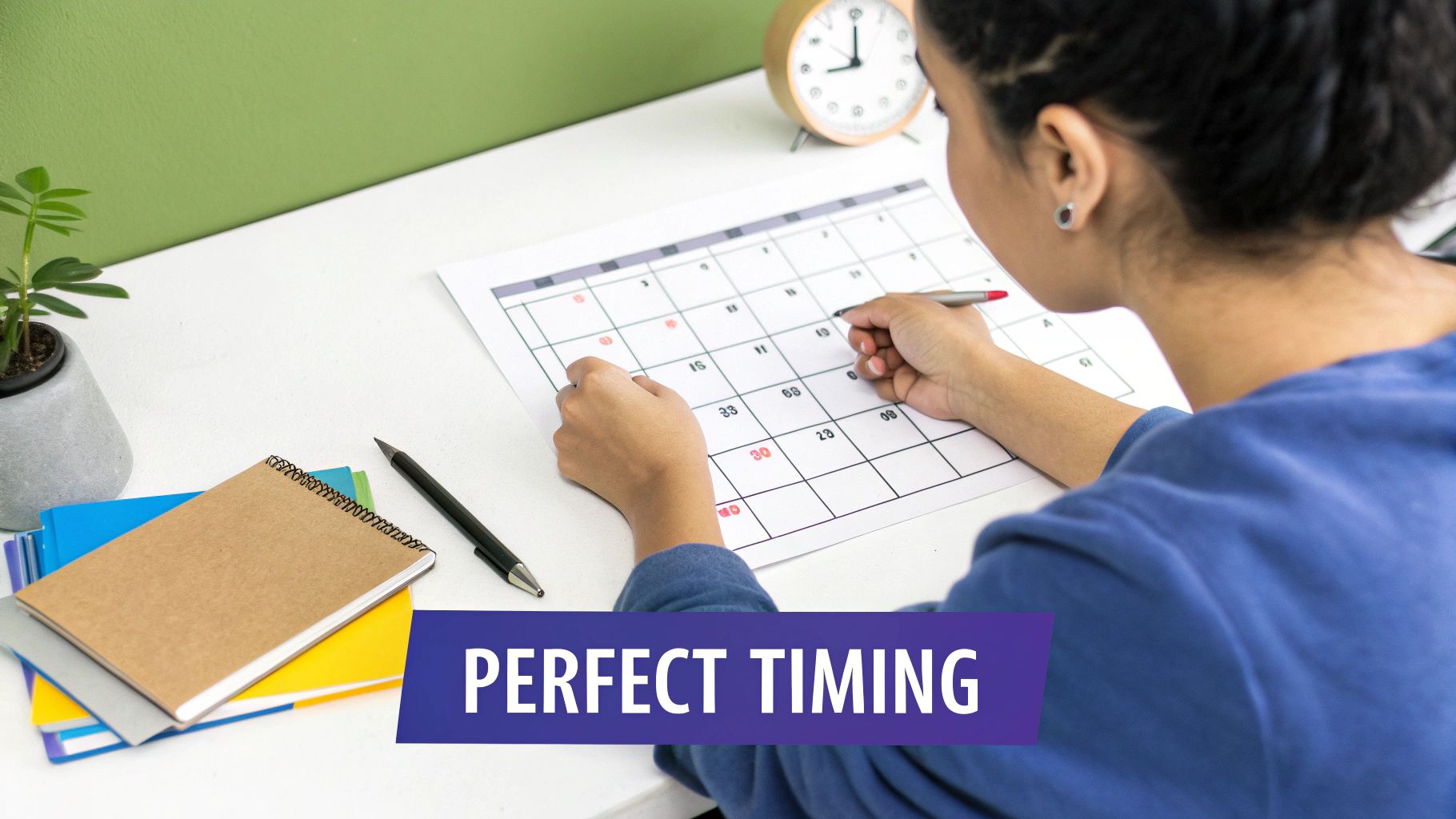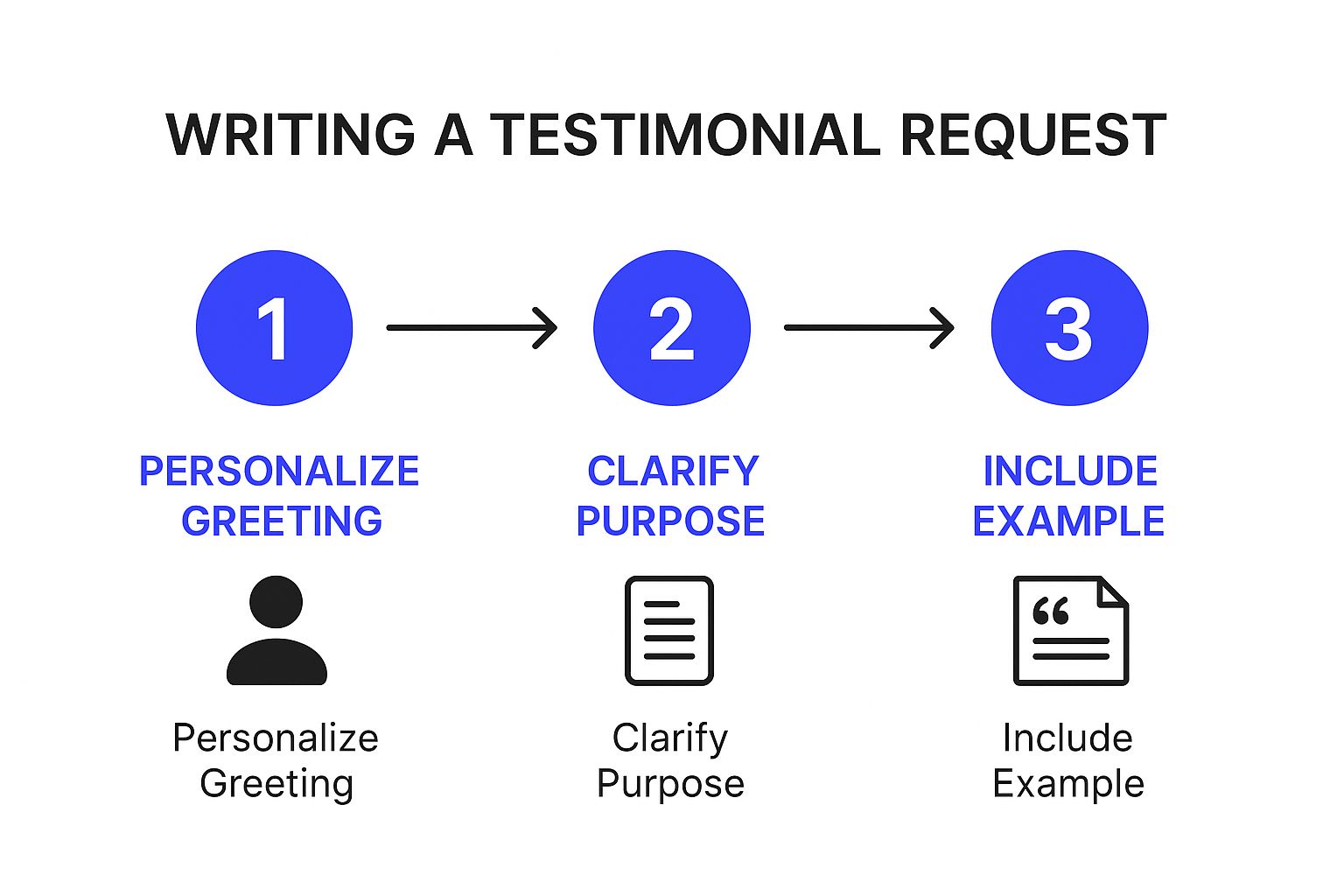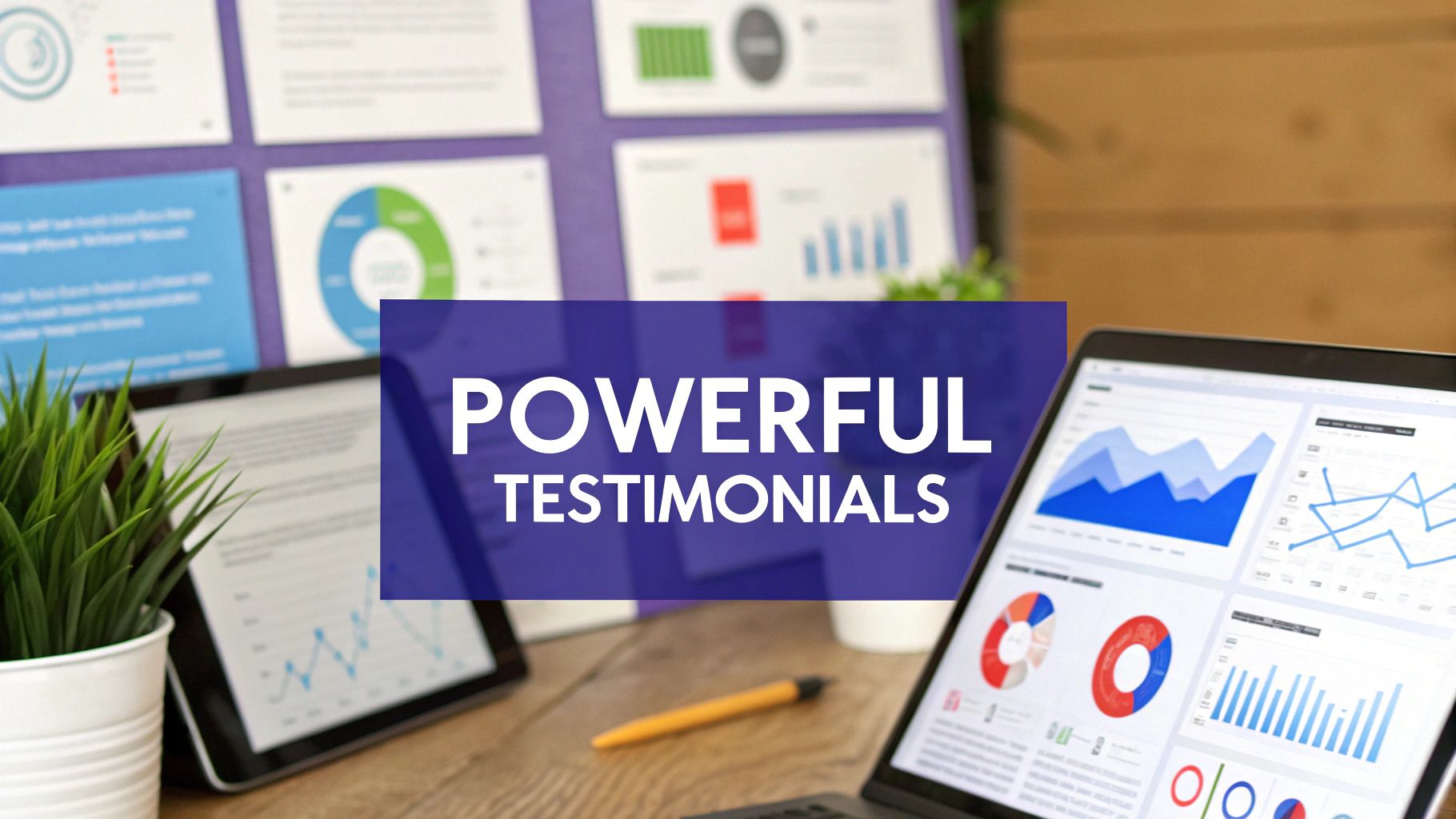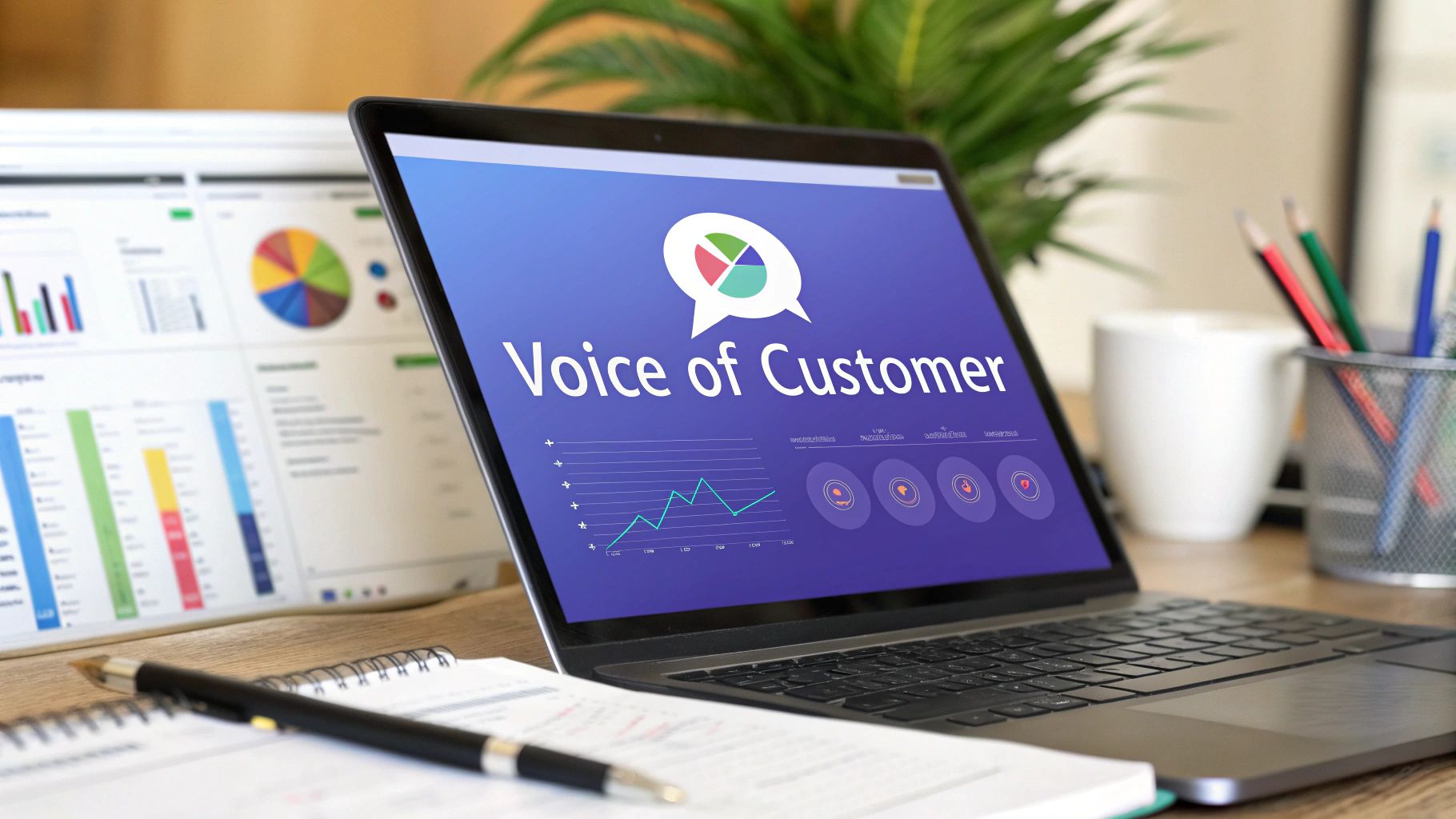How to Ask for Testimonials and Get a 'Yes' Every Time
Learn how to ask for testimonials that build trust. This guide reveals the best timing, templates, and strategies to get powerful customer stories.

If you want to get powerful testimonials, the secret is to make it personal, easy, and timely. Ask happy customers for feedback right after they’ve had a big win, give them a few simple questions to guide their story, and make sure the link to your submission form is front and center.
The Real Impact of Customer Testimonials on Your Growth

Let's be clear: customer testimonials are not just a nice-to-have for your website. They are a core growth engine, especially for SaaS companies where trust and proven value are everything. Authentic customer stories build instant credibility with skeptical buyers in a way that slick advertising simply can't.
When a potential customer sees someone just like them succeeding with your product, it creates an immediate connection. This social proof is a powerful counterweight to marketing promises, offering tangible evidence that you deliver on your claims.
The Financial Power of Authentic Voices
The influence of testimonials on buying decisions is staggering. Peer recommendations are a massive economic force, driving an estimated $6 trillion in annual consumer spending worldwide. This isn't just pocket change; it highlights their critical role in the buying cycle, often proving more effective than traditional paid ads.
This power comes from one simple thing: relatability. A polished ad might get ignored, but a genuine story from a peer cuts right through the noise.
A well-placed testimonial can be the final nudge a hesitant prospect needs to convert. It answers their unspoken question: "Will this actually work for me?"
Tying Testimonials to Customer Engagement
The best testimonials don't just happen. They're a direct result of strong customer engagement. Happy customers who feel heard and valued are far more likely to become vocal advocates for your brand. This creates a positive feedback loop: great service leads to powerful social proof, which in turn attracts more customers.
This is why understanding and implementing powerful customer engagement strategies is so crucial. It transforms a simple transaction into a real relationship, making the ask for a testimonial feel like a natural next step instead of a cold request. By focusing on the entire customer journey, you create the perfect conditions for generating those authentic, revenue-driving stories.
Pinpointing the Perfect Moment for Your Request
Timing is everything. Send a testimonial request too soon, and it feels pushy and transactional. Wait too long, and you miss that peak moment of customer excitement. The real secret is learning to spot and act on a customer's "happy moments."
These are the points in their journey where they feel most positive about your product, where its value is crystal clear. Asking for feedback right then feels less like a chore and more like a natural part of the conversation. You're basically framing their feedback as a celebration of their success.
And this isn't guesswork. It's about strategically identifying these key moments and, whenever possible, setting up alerts or automated triggers so you never miss an opportunity.
Key Moments to Watch For
The absolute best time to ask is right after a customer gets a clear win with your product. Depending on your SaaS, this could look like a few different things.
- After a smooth onboarding: The customer has everything set up and is primed to start seeing real value.
- When they hit a key milestone: Maybe they just used your software to wrap up their first big project or hit a usage metric that screams "success."
- Following a great customer support interaction: Your team just swooped in and solved a problem quickly and effectively. The customer feels heard, valued, and relieved.
- When they upgrade or expand their plan: This is a massive signal. They're literally investing more because they see the long-term value in what you offer.
When you align your request with a moment of real achievement, you capture genuine enthusiasm. The testimonial they give will be rooted in a specific, positive experience, which makes it far more authentic and powerful for your prospects.
Many teams I know use their CRM or a platform like Surva.ai to automatically flag these opportunities. This kind of system ensures you're always ready to capture a glowing review right when a customer's appreciation is at its highest.
Crafting a Request That Inspires a Great Response

The way you ask for a testimonial is just as important as when you ask. A generic, robotic request is easy to ignore, but a personal, thoughtful message makes customers feel seen—and genuinely eager to share their story.
Here's a little trick I've learned: stop asking for a "testimonial." Instead, invite customers to share their "feedback" or "experience." It’s a subtle shift, but it removes all the pressure and turns a formal request into a collaborative conversation.
Think of your request as a blueprint for an amazing story. Don’t leave your customers guessing what you want. Give them clear, simple prompts that help them recall those "aha!" moments they had with your product.
Personalize, Personalize, Personalize
A personalized opening is non-negotiable. Seriously. Mention a specific win they’ve had or a positive interaction you remember. It shows you see them as an individual, not just another user ID in your database.
Instead of a bland, "We'd love your feedback," try something with a little more life: "I saw your team just launched your new integration using our API—that’s fantastic! I’d love to hear more about how that process went for you."
That specificity makes them feel recognized and immediately reminds them of the value they got from your tool. The principles here aren't that different from effective sales communication. For more ideas on how to structure persuasive outreach, you can check out these sales follow-up email templates.
Pro Tip: Make it ridiculously easy for them to say yes. Send a direct link to a pre-built form or a simple survey. The less work they have to do, the higher your response rate will be. We built Surva.ai to let you create and embed these forms seamlessly.
Guide Them Toward a Powerful Story
Never, ever ask, "So, how do you like our product?" You’ll just get an equally vague answer back. Instead, you need to ask questions that gently pull out the story behind their success. For a deeper dive, our complete guide on how to properly request a testimonial has even more strategies.
Getting a story with a real before-and-after narrative is marketing gold. The key is to swap out those lazy, generic questions for specific ones that spark detailed memories.
Instead of a generic 'Can you give us a testimonial?' request, use targeted questions to get detailed, impactful stories. This table shows you how to prompt specific and valuable feedback.
Questions like these transform a simple review into a compelling case study.
And this kind of social proof is incredibly powerful. Recent data shows that 72% of customers trust a business more after reading positive testimonials, and featuring them can boost conversions by as much as 270%. These aren't just vanity metrics; they're the building blocks of trust and growth.
Putting Your Testimonial Collection on Autopilot
As your SaaS grows, manually hunting for happy customers and sending one-off emails just isn't sustainable. It's tedious, and great opportunities will inevitably slip through the cracks. The good news? You can set up an automated workflow that handles the heavy lifting for you.
This frees you up to focus on what really matters: nurturing the customer relationships that lead to those glowing reviews in the first place.
The secret is to build smart sequences that kick in right after a positive customer interaction. Think of these as "happy moments"—a high NPS score, significant feature adoption, or even a simple subscription renewal. These are the perfect signals to trigger a personalized, automated request.
Build Your Automated Funnel
What we're creating here is a simple but powerful funnel. It finds your most delighted users, sends them a perfectly crafted request, and follows up intelligently without ever feeling like a nuisance. It’s a set-it-and-forget-it system working for you 24/7.
Here's how to think about it:
- Pinpoint Your Triggers: First, identify the high-value actions in your customer journey. These are your green lights, signaling that a customer is satisfied and likely willing to share their experience.
- Design Your Sequence: Next, map out a short series of emails. The first one is your initial ask. If you don't hear back, a gentle follow-up sent about a week later often does the trick.
- Make It Incredibly Easy: The goal is a one-click response. Your email should link directly to a straightforward submission form, like the ones you can build with Surva.ai. If you're running on a different CMS, it's also worth checking out the best WordPress testimonial plugins to see what integrations are possible.
The image below breaks down the essential parts of a great written request.

As you can see, a successful ask always starts with personalization, clearly states what you need, and offers a quick example to get the creative juices flowing.
A well-designed automated workflow ensures you never miss an opportunity to capture a powerful testimonial right at the peak of a customer's satisfaction. It transforms a time-consuming manual task into a consistent, scalable engine for social proof.
While the automation handles the outreach, you still need compelling questions to get high-quality answers. For some great ideas, check out our collection of proven templates for testimonials. You'll find ready-to-use scripts that you can easily adapt for your automated sequences, ensuring your requests always feel personal and inspire a fantastic response.
Sending Testimonial Requests to a Global Audience? Read This First.
When you're asking for testimonials, cultural context isn't just a detail—it's everything. A direct, enthusiastic ask that lands perfectly in North America might come across as pushy or even aggressive in parts of Asia or Europe where communication is often more reserved.
If you use a one-size-fits-all approach, you're going to undermine your own efforts. You have to adapt your tone, language, and even your incentive to match local norms. It shows you genuinely respect your customers' world, which will dramatically boost your chances of getting a great response.
How to Tailor Your Request
To get this right, you really need to think about two things: directness and formality. Some cultures value a straightforward, get-to-the-point request. Others prefer a softer, more relationship-focused approach.
- For high-context cultures (like Japan or the Middle East): Don't just jump straight to the ask. Build some rapport first. Your request should feel like a natural part of a bigger conversation, not some out-of-the-blue email. The relationship comes before the request.
- For low-context cultures (like the USA or Germany): Clarity is your friend. Be direct about what you need and why it's valuable. These customers usually appreciate efficiency and a clear call to action.
The goal is to make your customer feel comfortable and respected. A request that feels natural within their cultural framework is far more likely to get a "yes."
This isn't just theory; it has a real impact on your business. Despite globalization, consumer mindsets often stay distinctly local, which means a standardized strategy just won't cut it in diverse markets. The most successful global companies know this and tailor their methods to fit. You can find more global consumer trend insights on Statista.com.
Showing this level of awareness does more than just get you a testimonial. It proves you see them as a valued partner, not just another user ID in your system.
Frequently Asked Questions About Testimonials

Even with the best game plan, some questions always seem to pop up. Let's tackle a few of the common ones I hear from teams who are just getting their testimonial process dialed in.
Is It Okay to Offer an Incentive?
Absolutely, but there’s a right way and a wrong way to do it. Think of it as a "thank you" for their time, not a payment for a five-star review. The goal is to show appreciation while keeping their feedback completely genuine.
- What works well: Small discounts on their next bill, a free month of your service, or even a modest gift card.
- The right time to offer it: Give the gift after they’ve submitted their testimonial. This keeps things authentic and avoids any feeling of a transaction.
What if a Customer Ignores My Request?
First off, don't take it personally. Your customers are busy people. It’s perfectly fine to send a single, gentle follow-up email about a week later. If you still don't hear back, it's best to let it go.
Pestering a happy customer is a surefire way to kill the goodwill you've built. Just move on and focus your energy on another satisfied user who might be in a better position to share their story.
The golden rule here is to respect your customer's time and inbox. One polite follow-up is professional; anything more becomes an annoyance that can damage the relationship.
Can I Edit What a Customer Writes?
You can, and honestly, you often should—but only for minor tweaks. Cleaning up a typo, fixing a small grammatical error, or trimming it for brevity is fine. What you can never do is change the core meaning or the original sentiment of their feedback.
If you need to make more significant edits, maybe to fit the testimonial into a specific marketing piece, always send the revised version back to the customer. Ask for their final sign-off before you publish it. It's a simple step that shows respect and protects your credibility. For more on keeping things authentic, check out our guide on how to get customer testimonials.
Ready to turn happy customers into your most powerful marketing asset? Surva.ai gives you the tools to automate your testimonial collection, from identifying delighted users to sending personalized requests. Stop chasing feedback and start building social proof on autopilot. Start your free trial today.


